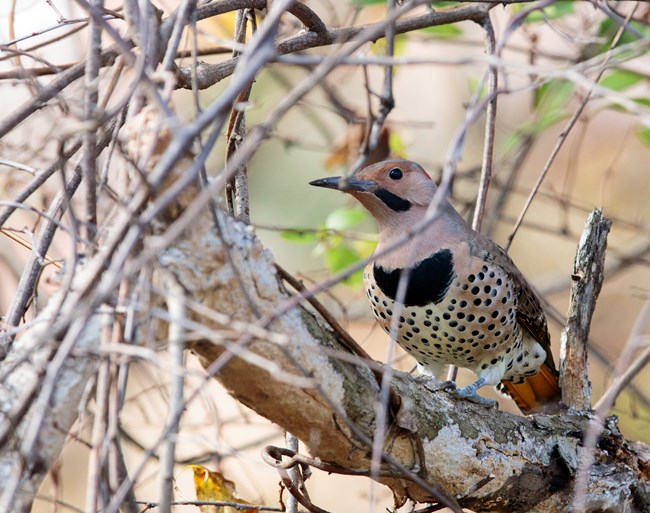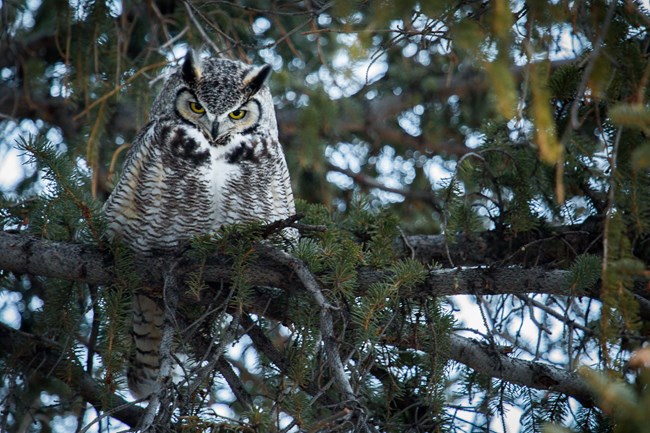
NPS Photo
Due to the blend of prairie and forest ecosystems, Wind Cave is home to many different species of birds. Over 100 species make the park their permanent home, with many more passing through the area during spring and fall migration. This makes the park a bird watching hotspot. A printable bird list is available at the bottom of the page. 
NPS Photo / N. Lewis East Meets WestThe Black Hills are centrally located in the United States, so this means that birds typically seen on either the east or west sides of the country can also be found here. If you are from the west coast, the eastern bluebird or red-headed woodpecker might be an unusual sight. However, if you are visiting from the east coast, the black-billed magpie or golden eagle might stand out. This meeting of east and west is well represented by the northern flicker, a woodpecker found across much of the US and Canada. These colorful birds look different on different sides of the US. On the west side of the country, males have a red “mustache stripe” and red wing and tail feathers. On the east side of the country, males have a black mustache stripe and yellow wing and tail feathers. At Wind Cave, male northern flickers usually have the black mustache stripe of an eastern bird but the orange or red feathers of a western bird. 
NPS / Peelee Clark From the Prairie...Much of the park’s 33,000 acres are made up of prairie. The rolling grasslands of Wind Cave are a mix of both eastern tallgrass and western shortgrass prairie. Upon closer inspection, many birds make a living among the waving grasses. Western meadowlarks are a common sight and sound in the summer as they sing from tall perches. Both eastern and mountain bluebirds are often seen catching insects near fence lines. Ground birds like wild turkeys or the elusive sharp-tailed grouse may be seen wandering through the grass in flocks. Colonies of prairie dogs provide food and habitat for many of the park’s birds. Prairie dogs are one of the favorite foods of several birds of prey including golden eagles and red-tailed hawks. Scavengers like turkey vultures and magpies often visit prairie dog towns to feed on dead prairie dogs. Burrowing owls return to the park each year and use prairie dog burrows to raise their chicks. These tiny owls blend in well with their four-legged neighbors. 
NPS Photo / Neal Herbert To the Forest...The ponderosa pine forests that define the Black Hills provide habitat for birds that would not normally be found in the prairie. Owls like the great horned owl, long-eared owl, and northern saw-whet owl make their nests in trees and hunt for prey at night. Sometimes called “flying flames,” brightly colored western tanagers stay for the summer and feed on insects and fruit. Cedar waxwings are a common sight throughout the year. The forest is also a haven for woodpeckers like the red-headed woodpecker and hairy woodpecker. If you are lucky, you may catch a glimpse of the black-backed woodpecker. Most of these birds are found in Canada but a small isolated population exists in the Black Hills. 
NPS Photo / Larry Putnam ...And Everywhere in BetweenThe areas around the Elk Mountain Campground and visitor center have more shrubs and underbrush than most other areas of the park. This attracts songbirds in large numbers. Many species of warbler including the common yellowthroat, yellow warbler, and the very vocal yellow-breasted chat are seen each year. Wrens and colorful orioles often make an appearance near the visitor center as well. Wind Cave lacks large bodies of water, so water birds are fairly uncommon. However, during wet years, a seasonal pond near the intersection of Highway 385 and the southern end of the visitor center road may be sustained for days, weeks, or even months. When present, this pond becomes a welcome rest stop for waterfowl and migrating birds like ducks and geese. By preserving and managing habitats within the park, Wind Cave National Park works to maintain this highly diverse bird community. Select a Park:Select a Species Category (optional):
Search results will be displayed here.
|
Last updated: July 25, 2023
